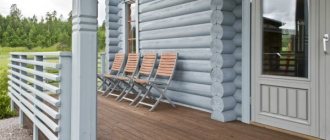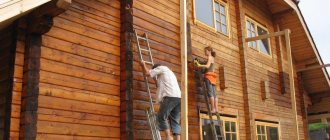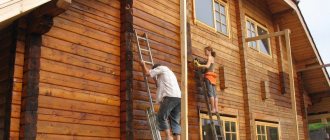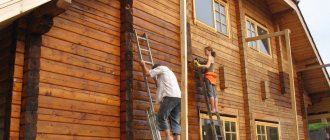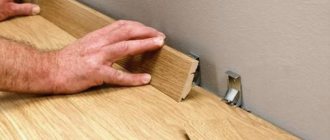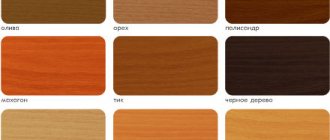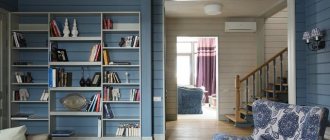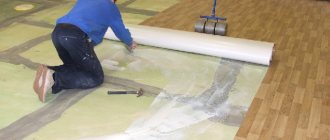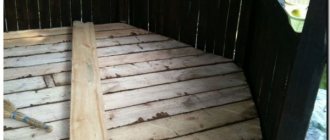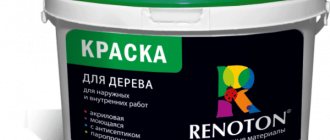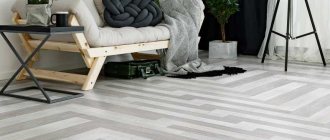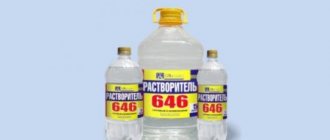Wood is a natural, non-toxic material that fills a home with warmth and comfort. In combination with wooden walls, a wooden floor looks especially harmonious and attractive.
Today, the technology for laying floors in a wooden house has significantly improved. Modern floors are distinguished by their abrasion resistance, moisture resistance, hygiene, sound insulation, durability, ease of cleaning and aesthetics.
Types of Wood Flooring
This section could be missed if many people did not confuse parquet with parquet boards, and parquet boards with solid wood. In fact, only two types of flooring are made from solid wood:
- massive board;
- parquet.
Both of these products are made from solid wood; processing is used only to impart the necessary performance or aesthetic qualities. This is a natural, durable material.
The difference between solid wood and parquet is in size: parquet is much smaller. The average size of parquet planks is 50*600 mm, thickness 15-16 mm, and a solid board can be from 60 cm to 6 m in length, from 7 to 20 cm in width, the thickness varies widely.
Parquet boards cannot be classified as solid wood flooring, since they consist of three layers, and only the top one is made from solid expensive wood, the rest are cheaper coniferous wood. Parquet board is a more affordable coating, the durability of which is lower than that of a solid board, which is explained by the smaller number of possible sandings, because the layer of valuable wood here is many times thinner.
The choice of wood type depends more on the room in which the coating will be used, what conditions it will be in, and what loads will affect it. As for the species and type of coating, with rare exceptions, most types of wood are used to create parquet and solid boards. Ash, beech, pine, birch and oak are most often used for parquet boards.
Wood floor construction
In this case, the base can be compacted soil, brick pillars or an interfloor reinforced concrete floor, if we are talking about the floor structure of the upper floors. This is followed by a waterproofing layer, for which roofing felt or roofing felt is usually used.
Wooden logs are installed on top, between which insulation is laid. Then follows a layer of vapor barrier film. And floor boards are already laid on it - often in several layers.
Oak wood - strength and luxury
Oak is the best option for making any type of flooring. This is a standard that serves to evaluate other types of wood. In terms of strength and hardness, oak is often compared to concrete. The color range of wood is wide, there are about 200 shades : from light yellow to dark brown interspersed with green and gray. Over time, oak tends to darken a little, which makes its appearance even more luxurious. The annual rings are clearly visible on the wood.
Solid boards and oak parquet can be produced with or without varnish. It all depends on personal preferences and the style of the interior: a board without varnish is an option for Scandinavian and eco-style, with varnish is for the Rococo, classic, modern style.
Main advantages of oak:
- high hardness, strength and durability, abrasion resistance, therefore oak floors are used not only in residential premises, but also in restaurants, clubs, offices and other premises with high loads;
- high resistance to fire and moisture, oak is not susceptible to rotting and the spread of fungus. Thanks to these properties, it has found application in rooms with high humidity (kitchens, baths and even baths with saunas);
- high sound insulation properties;
- excellent aesthetic qualities, beautiful natural pattern.
drawback - the high cost, but the investment pays off, because oak parquet or boards can last for decades.
Scope of use : residential and public premises, hallways, baths, kitchens, saunas and baths.
Comparison of the strength of wood species
Properties of coating materials
Wooden flooring must be coated with a protective compound.
Floorboards, parquet or plywood should not be left untreated. There are various impregnations and coating materials that add strength to wood. The entire range of materials is designed to protect the tree from:
- exposure to high humidity;
- insects, mold and rot;
- drying under the influence of UV rays;
- rapid aging.
Of course, not all of these qualities are combined in different proportions in the coating, so depending on the location of the flooring, it is worth choosing a wood processing material.
In addition, modern interior designers use just under a hundred different types of wood in their work, which have distinctive performance properties and require different care.
Ash is a direct competitor to oak
Both parquet and solid boards are also made from ash; it is used to make parquet boards - it is equally good in all areas of use. In terms of strength, it even surpasses oak , and the fact that baseball bats and sports equipment handles are made from ash speaks for itself. Wood has a light shade, so it is often used in cases where it is necessary to visually expand the room and bring warmth into it.
Advantages:
- high strength, wear resistance and elasticity. Ash is used for finishing gyms, not to mention residential and commercial premises;
- excellent appearance;
- good thermal insulation qualities.
The disadvantages are the high price and low resistance to low temperatures and temperature changes, but this will not be a problem for an apartment.
Area of use: residential and commercial premises, hallway, kitchen, gyms.
Engineering board (technomassive)
Unlike a parquet board, where the top layer is small blocks of parquet and solid wood, where the board consists of one type of wood, an engineered board or, in other words, technical solid wood is a veneered and laminated layer of inexpensive wood. The first layer of the board consists of inexpensive wood, topped with veneer (a thin layer of wood) and lamination.
I recommend: Question: Why does brick crack before and after firing?
Engineered boards can be produced up to 3 m in length, which allows you to seamlessly cover large areas.
Engineering board or technomassif
Siberian larch – durability and moisture resistance
Among all conifers, larch is the strongest and most durable. The unique performance qualities of wood are explained by the most difficult growing conditions . Under constant exposure to moisture, larch does not rot, but becomes denser. In terms of strength, it is only slightly inferior to oak, but in terms of durability, it is catching up with it. Many European architectural monuments with a long history still have larch floors. Moreover, the piles on which Venice is built are made of this very rock.
Advantages:
- century-long durability;
- moisture resistance, resistance to mold and mildew due to unique antiseptic properties. Larch wood is used for arranging piers, terraces, baths, bathhouses;
- hardness and wear resistance allow larch to be used in restaurants, shops and gyms;
- has more than 10 different shades, perfectly retains color and texture, and does not darken.
Larch is more expensive than pine, but its performance cannot be compared. If we take into account the service life and resistance to almost all negative factors, then larch can be called a very profitable investment. It is only important to choose correctly treated wood, otherwise a significant part of the natural qualities will be lost. You can trust the products presented on the page https://lesinter.ru. The manufacturer specializes in the production of lumber from Siberian larch, has its own resource base, has the most modern equipment at its disposal and delivers products not only throughout Russia, but also to the USA, Japan and Western Europe. The company's product range includes parquet and solid larch boards, as well as decking boards, planks, lining, block houses and other products. All products meet European quality standards.
The scope of use of larch wood: residential and public premises, kitchens, baths, saunas, as well as houses where the owners are not present all year round.
Stage two – finishing
To enhance the dirt- and water-repellent properties of the new floor, make the surface more resistant to abrasion, and, accordingly, increase the service life between renovations, we recommend applying colorless oil with hard wax as a finishing coat.
So, the restoration of the floor is completed. It took a little effort to achieve an exclusive, environmentally friendly, easy-to-care finish that's easy on the eyes!
vote
Article rating
Coniferous wood: pine, spruce and fir
Pine, spruce and fir wood has gained popularity due to its low cost. If funds allow, it is better to focus on other breeds. Coniferous wood is used in rooms where it is not customary to wear shoes. Solid boards and parquet are produced from it (it is important that the elements have a tongue-and-groove joint), and it is also used to produce different layers of parquet boards.
The properties of coniferous wood are far from ideal, so their scope of use is very limited:
- pine It is distinguished by the presence of a large amount of resin, which protects the wood from rotting, has an excellent appearance, has high vapor permeability and releases phytoncides into the air, which is a natural antiseptic. The main disadvantage is low hardness, so even the legs of more or less heavy furniture may leave marks. Can be used in bedrooms and living rooms;
- is even less durable than pine, therefore it is used extremely rarely for the production of floor coverings;
- fir is inexpensive, has a pleasant appearance, has healing properties, does not emit resin and does not “cry” at high temperatures, but is afraid of moisture and has low strength. We do not recommend using fir as a flooring material.
Varnishes and paints
The chemical composition of varnishes for wood coatings includes natural resins or synthetic polymer compounds.
Thanks to this composition, varnishes create a hard protective film on the surface of the wood, protecting the material from fungus, insects and moisture.
At the same time, the varnish preserves the texture and enhances the brightness of wood tones. The basis for the formation of the varnish composition determines the quality of the solvent. For different types of varnish the following are used:
| Type of varnish | Solvent type | The basis |
| Turpentine | Liquid resins | natural resins, turpentine, linseed oil |
| Oil | Vegetable oils | soluble resins and vegetable oils |
| Alcoholic | Various types of technical alcohols | Natural resins, rosin |
| Water-dispersed | Water | modified polyurethane dispersions |
Depending on the solvent, the time it takes for varnishes to reach maximum strength varies.
This process occurs most quickly with alcohol varnishes. The surface, opened with such varnish, is ready for use immediately after the coating has completely dried and gained maximum strength.
Water-based varnish gains strength within 10 days; you should not use such a floor earlier; the coating will lose its gloss and evenness.
There is a misconception that water-dispersion varnishes are inferior to others in terms of coating strength. After complete drying, a layer of such varnish is not only not inferior, but often surpasses other types in strength.
Paint is easy to apply with your own hands
Wood paint has the same properties as varnishes, with one difference - this type of coating is opaque.
The most commonly used are acrylic and alkyd coatings. The advantages of paint for wood include:
- ease of coating,
- ease of maintenance of the treated surface,
- budget,
- long service life of the coating.
Among the disadvantages there is only one property: the paint hides the natural beauty of the wood, and the material looks rather unaesthetic. For more information on how to paint the floor in a wooden house, watch this video:
Alder - durability and benefits
In terms of strength and durability, alder is not much inferior to oak and has healing properties.
Advantages:
- resistance to deformation;
- the tannins contained in wood have a positive effect on the microclimate of the room;
- sufficient resistance to moisture.
Area of use : bedrooms, living rooms, children's rooms, bathrooms.
How to paint wood so that the structure is visible
A wooden floor with visible structure and fibers is pleasing to the eye of any person. This pattern emphasizes the natural origin of the material. But in order to preserve it, give it practicality and durability, it is worth selecting materials with certain quality characteristics. Varnish, various impregnations and stains can be used as a treatment. A wooden floor with such a pattern must be leveled and properly processed. Sometimes double or triple impregnation of surfaces is carried out, but the effect, stylization and safety of wooden coatings in this case will be one hundred percent.
Aspen – excellent moisture resistance
Aspen wood is used infrequently and this is primarily due to superstitions. But if you use common sense, you can find a lot of positive qualities. This is both the ability to release useful substances into the air and resistance to moisture, which is why massive aspen boards are often used even for arranging individual areas in a bathhouse.
Available types of wood treatment compounds
Reliable and effective protection of wooden structures from harmful external influences can be ensured using the following compounds:
- wood varnish;
Polyurethane varnish Pallmann IS 90 Sport for wooden floors
- wax products;
- oil based coatings.
Each option mentioned will give the wooden floor an attractive appearance, while at the same time ensuring increased resistance of the material to various types of influences and loads and helping to extend its service life.
Hard wax oil for wooden floors Saicos
Next, you are invited to familiarize yourself with a description of the basic properties of varnish, wax and oil, as well as study the technology for applying each of these materials. But first you should definitely understand the procedure for preparing the surface for subsequent processing.
Oil-wax
Maple – strength and elasticity
Maple wood is considered one of the lightest, and under the rays of the sun it acquires a pleasant golden hue. The main advantages a unique pattern, hardness, bending strength, elasticity, but it is not recommended to use maple boards in rooms with changes in humidity levels, so this flooring is used only in bedrooms and living rooms, and even then not very often.
Wood: pros and cons
Wood is environmentally friendly and has good heat-insulating properties.
What types of coatings exist and what qualities do they add to wood? Let's determine the natural advantages and disadvantages of natural materials.
When installing a wooden floor in a room, the owner must understand what qualities the floor will have and what it will have to deal with.
The advantages of this material include excellent thermal insulation properties, sufficient strength, ease of repair and environmental friendliness.
The disadvantages include:
- low level of sound insulation;
- high moisture absorption;
- instability to abrasion and mechanical stress (depending on the type of wood);
- changes in physical properties under the influence of temperatures and humidity levels;
- easy flammability;
- susceptibility to rotting;
- not resistant to insects and microorganisms.
When choosing a material for processing wood flooring, you should give preference to the type of coating that will strengthen the weak points, while maintaining the natural texture and environmental friendliness.
Cedar - expensive and reliable
A huge part of cedar wood is exported, so it is not so easy to get it here, and it is expensive. Cedar is valued for its many benefits :
- resistance to high temperatures and humidity, which is achieved due to the special fibrous structure of wood;
- high content of healing essential oils in wood;
- high strength and durability.
Scope of application : living quarters, kitchens, baths, saunas, bathrooms.
Procedure for applying varnish
Various tools are used to apply varnish. So, for example, quick-drying water-soluble compounds are applied with rollers of the highest quality. The performer must distribute the material over the surface using exclusively translational movements. First, the product is applied across the flooring, after which it is leveled in the longitudinal direction, i.e. the surface is varnished “crosswise”.
Procedure for applying varnish
You can use a spatula to apply the first layer of material. The performer makes fairly quick S-shaped movements, evenly distributing the composition over the base. This technology allows for higher coating strength.
If using a brush, the material should be applied in neat U-shaped strokes. In this case, the new stroke should slightly overlap the previous one.
It is most convenient to start work from the wall opposite to the exit from the room - this way you will not have to walk on the applied composition.
The most popular board coverings
Wood is one of the most popular materials for flooring. It is superior to other coatings in terms of wear resistance, durability, and reliability. Its most important advantage is its high environmental friendliness. To ensure that floor boards do not lose their characteristics, they are treated with protective agents.
Among the most popular natural and synthetic compounds are:
- mastics;
- varnishes;
- paints;
- impregnation.
Each product has its own advantages and can be used in certain conditions. What they have in common is that they protect wood well from moisture, chemical and mechanical damage, emphasize and maintain for a long time the aesthetic appeal of the natural pattern and structure.
Manufacturers of paint and varnish products offer decorative products for wood with different component compositions. They differ from each other in service life, price and have some individual characteristics. When choosing a composition for covering a wooden floor, you should take into account the advice of experienced builders:
- take into account the type of wood;
- quality of preliminary preparation of boards;
- the nature of the room and the conditions for further use of the floor;
- possibility of re-processing the wooden floor;
- compatibility of the product with the previous coating.
The choice of the optimal composition is influenced by the price issue. There is no need to skimp here. The best product from a trusted manufacturer with a good reputation may not be cheap, but it will save you from unnecessary hassle in the future.
